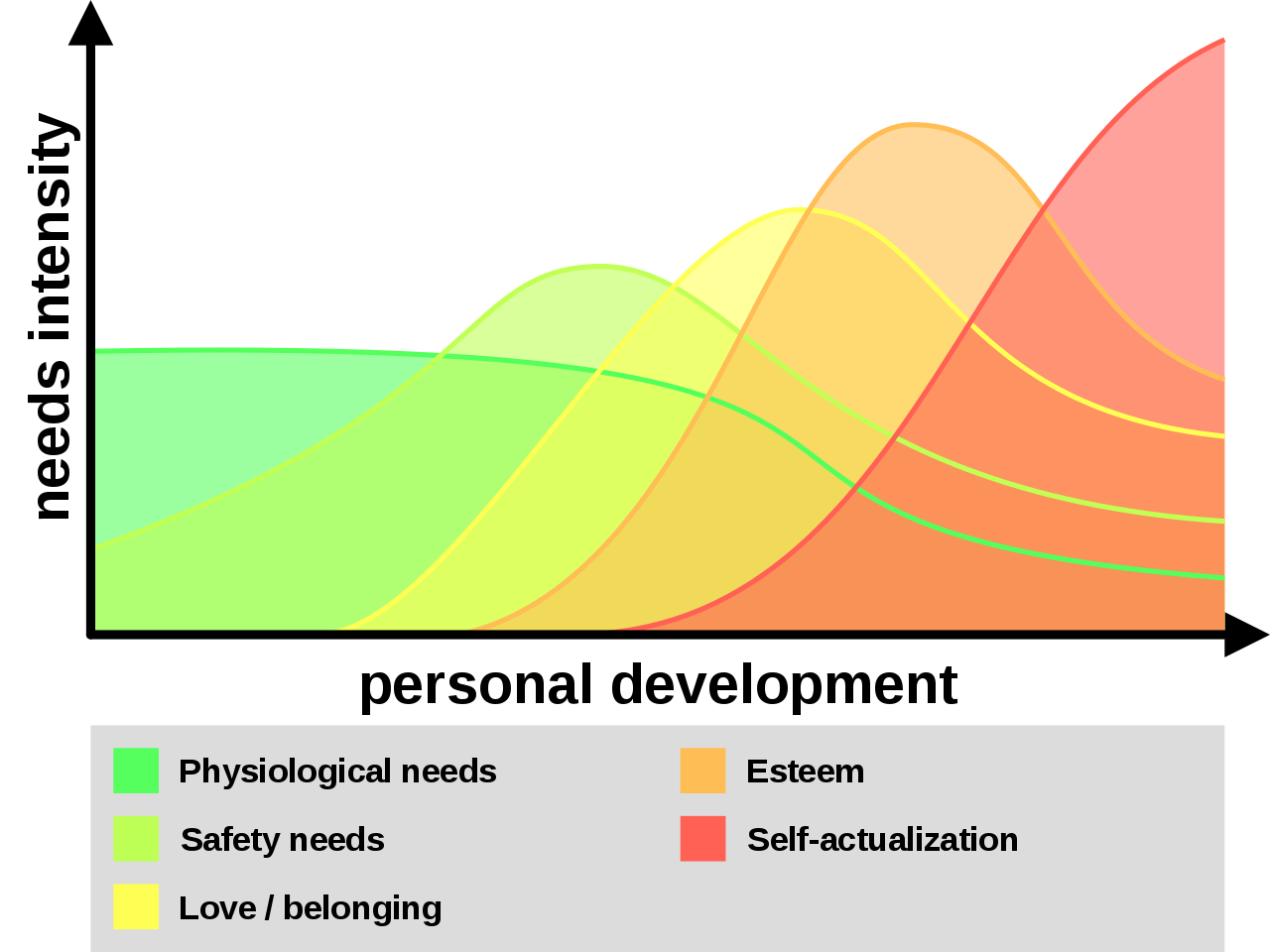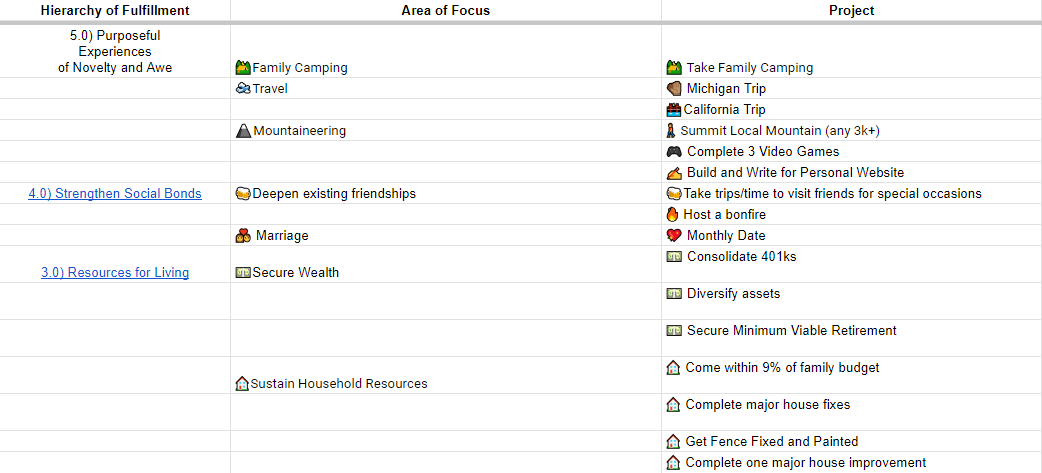October 01, 2023
Hierarchy of Fulfillment
The Hierarchy of Fulfillment (HoF) is my experimental framework that loosely applies David Allen's 5 Horizon's of GTD to each tier in Maslow's Hierarchy of Needs and indirectly inspired by Steven Covey's 7 Habits of Highly Effective People and a slight dash of Charles Duhigg's The Power of Habit or James Clear's Atomic Habits.
HoF is expressly not a productivity system like GTD, nor an psychological explanation of human behavior like Maslow's Hierarchy of Needs. The Hierarchy of Fulfillment is a framework for thinking about what goals, targets, projects or objectives are worth doing. In its simplest form, one could think of it like a better-informed "bucket list".
Disclaimer
HoF is perhaps a not well informed attempt to assure I am working toward both near and long term goals for every important area of my life. It is however possible that attempting to have such a holistic approach to every important aspect of life is a bit counter productive and a type of toxic productivity. Given that Maslow's Hierarchy of Needs has 5 tiers and David Allen's GTD has 5 horizons, there is up to a possible 5 x 5 = 25 targets to manage.
As an experiment, I've been iterating on the framework each year since 2018 when it started as my first application of GTD's 5 Horizons.
Framework Introduction
There are two major components to the HoF:
- Tiers representing major areas of focus, which closely resemble Maslow's Hierarchy of Needs
- Horizons which represent the near-term vs far-term nature of each of the areas of the tiers above. The horizons approximately correlate with David Allen's GTD Horizons.
Of course underpinning these components are a set of habits and processes which is well informed by GTD itself, so most of this framework is derivative. It is also very experimental and small-batch with a sample size of just me.
Tiers
As of 2023 the tiers are articulated slightly different than Maslow's Hierarchies but a there are a couple that still map though perhaps not one-to-one:
| HoF | Maslow's Hierarchy of Needs |
|---|---|
| 1.0) Infrastructure of Self | physiological |
| 2.0) Capabilities of Self | |
| 3.0) Resources for Living | |
| 4.0) Meaningful Social Bonds | belonging and love, esteem |
| 5.0) Experiences of Novelty and Awe | self-actualization, transcendence |
Being a hierarchy, it is given that in order to support a higher tier in the hierarchy, each of the lower tiers must first be satisfactorily fulfilled as a prerequisite. For example, you may have heard the adage "You can't help others if you don't help yourself." It isn't to say that all Infrastructure of Self horizons must be completed before working on _ Capabilities of Self_ but rather each completed objective in the lower tier enables the completion of a higher tier goal. This idea can be expressed by an updated model of Maslow's Hierarchy of Needs where each 'tier' actually only needs to be sufficiently fulfilled before some work on the next tier can be done.

Dynamic hierarchy of needs of Abraham Maslow referring to Krech, D./Crutchfield, R. S./Ballachey, E. L. (1962), Individual in society, Tokyo etc. 1962, S. 77 cc license
Horizons
Additionally, each tier will have at least five targets or goals - at least one for each of GTD's five horizons. The near-term horizons are not just from the nearest term objectives, but also the daily habits that are intended to be created, practiced, or reinforced. The furthest horizons are aspirations more than achievable goals as you can always approach the horizon, but never get to it. These are journeys more than destinations. Like HoF's tiers loosely map to Maslow's Hierarchy of Needs, HoF also loosely maps to David Allen's GTD 5 Horizons:
| HoF | David Allen's GTD 5 Horizons |
|---|---|
| Hof Tier (eg: 1.0) Infrastructure of self) | "Purpose & Principles" |
| Area of Focus | "Vision" |
| Project / Habit | "Projects & Priorities" |
| Tasks | "Calendar/Actions" |
The concept of shearing layers or pace Layering and its accompanying linkages applies here in that the short-term actions enable long-term results. The velocity of the nearer term tasks and projects enable the achievement of the longer term, slower moving Vision, Purpose, and Principles.
Tiers and Horizons Combined
With both the tiers and horizons combined, I have a sorted list of major areas of life, areas of focus within each, specific projects to support those areas, which is a "map" to achieving everything identified as important. Here is a partial and slightly fabricated example:

Exceptions
It can be quite suffocating to map out everything that I need or want to get done, so each year I've been reducing the number of projects to track. This also leaves room for serendipitous opportunities that come up throughout the year. I've also learned that it is good to include line items for hobbies, and non-productive activities. I've also never had a year where I've 100% completed everything - and that is ok. I believe it is more important to set high targets and strive than to actually meet them all.
In future posts about this topic, I intend to define the tiers and horizons in more detail, share examples of projects in each of the tiers, and supporting reasoning for the particular tiers and horizons that I've defined. I'll also share some of the recurring processes (daily, weekly, monthly, yearly) that support / are supported by this framework. Finally, I'll share some of the results and supporting software tooling that I use to manage and tie it all together.